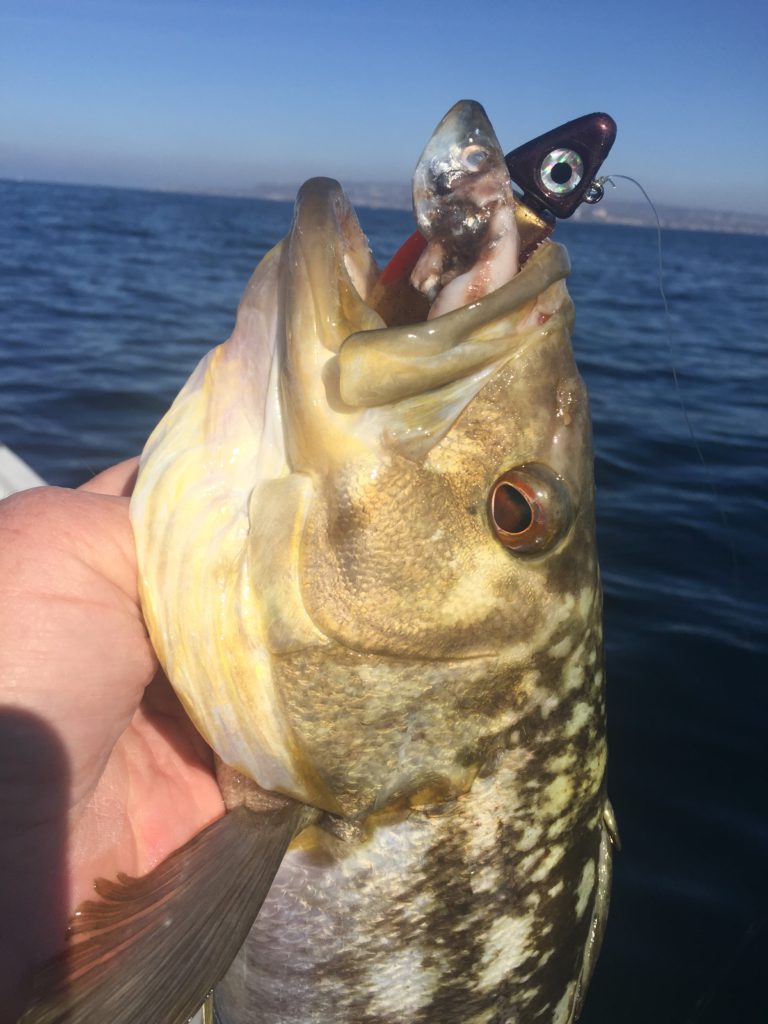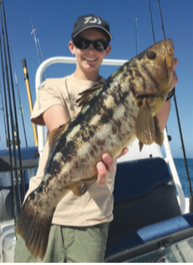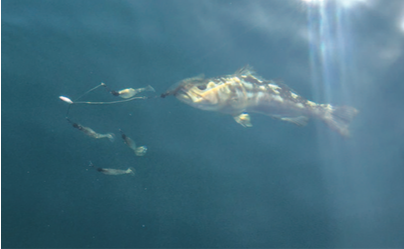BY CAPTAIN BILL SCHAEFER
SAN DIEGO – You want to go calico bass fishing, but the weather is not cooperating. Storms are starting to hit the Southern California coastline and water temperatures are cooling off. Don’t give up as the calicos and the sand bass are just sliding out onto deeper structure. Last winter brought some great fishing for myself and my friends off artificial reefs, drop offs and even sunken boats off the Southern California coast. You too can enjoy this type of fishing, you just have to search for the correct areas to fish.
You see, up and down the coast are man-made structures such as pipes with giant rock boulders covering them. Over time they have become reefs, holding all types of life and the entire food chain. There are also old bridge pilings, concrete pieces, sunken boats, as well as natural contours of the bottom. Rebar can make them tackle takers, but just use a weedless jig- head and it should cut down on your retying all the time.
Also, let your fingers do the walking on the Internet. Many reefs are there to find on various webpages who promote this type of fishing. A lot of them publish the exact numbers to the reefs around Southern California. You can add them to your GPS/Sonar and store them to try once you’re on the water.
Old maps can be a great source as well for spots. Look for fish symbols on old maps or even on your mapping unit on your fish finder. They can be old, but if they’re on the map or unit, it was a hot spot at some time for them to place it there.
If you have enough of these targets/reefs stored in your mapping unit, then

you will have the targets you need to fish all winter and be successful. You will, of course, need a fish finder with mapping capabilities to mark the spots, but if you don’t have mapping on your unit, a small handheld unit would work too. If you only have the fish-finder you’re still in business as so long as you can read the contours of the bottom or the targets. Line up two fixed points on land to find and return to the spots you like if nec- essary. You can also carry a notebook to make notes on your favorite spots. Even some less expensive fish finders have GPS/mapping and higher resolution than older models and will really help you out.
Can you tell the bass from the schools of rockfish on the structure? Yes, if your unit has high resolution, such as my Lowrance HDS 12 LIVE Sonar. On structure, the rockfish tend to look more like a school of bait only a little larger in make-up. The bass tend to look more like streaks or the classic hooks you have come to recognize. Even though they slide out to deeper water or are on, say, a pile of old bridge pilings, they can be up off the bottom chasing baitfish and feeding. If this is the case then you will usually see a ball of some type of bait above them and the streaks on your meter running through that bait are the bass. They can also be up prowling in wolf packs or schools and not actually feeding and will look like just slightly elongated hooks. No matter where you find them, it’s always worth a few casts.
At these depths there is a lot of food for them to feed on, so it won’t always be a classic ball of some type of baitfish. Marks on the bottom can mean that they are feeding on crabs, including red crab, lobster, shrimp, octopus and even squid. Some of these can look like a ball of something on your meter, but it will be hazy and almost clear because of their makeup. You will learn to identify them over time. Watch what the bass spit up when they hit the deck, throw them in the live well or bait tank, or when you throw them back. Many times what they are eating has helped me in a tournament by match- ing the hatch. If you come close, shape or color-wise, then you should temp them into eating your lure. Even the fall of the lure can make a difference.
Speaking of that, the fall of the lure can be a game changer. Think about how a red crab just drifts with the current. One tournament we couldn’t get bit until we went to a lighter head so the bait would just drift down slowly. Usually, you will need a heavier head than fishing the kelp, but it can still be anywhere from half ounce to 2 ounces. You don’t want any more weight than you need. Wind and current can play a part in your choice more than you think. If you see that the fish are up off the bottom on your sonar, then don’t go too heavy as your bait will fly right past them. Most of the fish may not even see your lure go by. A lighter living rubber jighead, like a Reebs or Warbaits, trailed with a swimbait, creature bait, or giant grub will work well when the fish are keyed on red crab.

Again, the size of your jighead can be key to the fall of the bait, but so can the swimbait you choose. Have you ever been fishing with a buddy and he keeps catching and you don’t. Different swimbait manufacturers all believe in the design of their bait, especially the tail and the vibration it puts out. Larger thumping tails to quicker vibrating tails and everything in between make a difference. If you are not catching, then don’t hesitate to change baits, but not just color, but the shape of the tail. It’s good to carry different companies’ swimbaits, but also in the same colors. That way you can still emulate the baitfish, but also adjust the vibration of the tail. Big Hammer, MC Swimbaits, LK Lures, Reyes
Swimbaits, Reebs Lures and Western Plastics are just a few of the companies you should try out. For colors, match the hatch with something similar to what the fish are spitting up if you see it.
As I mentioned, the bass can be out in deep water but feeding up off the bottom. Other lures like spinnerbaits, various jigs, iron, spoons, crankbaits, jerkbaits and umbrella rigs can attract the bite. The crankbaits can dive down to the bass; the iron is heavy enough to fall to them; the jigs are weighted as well; and spinnerbaits in the 1- to 2-ounce size will get to the bass. Umbrella rigs do well on feeding bass as they emulate a school of baitfish. It’s fun to use different lures at times to enhance the experience and the fun of catching. Experimenting can be great, especially when you hook up.
This brings us to the tackle you’ll need. Don’t panic because the tackle you use in the kelp will work on the deep areas as well. My favorite rod and reel combo is the Daiwa DXSB Swimbait rod with a Lexa 300 WN reel and 15-pound Maxima Ultragreen line. You are out in deep water and once you get the fish coming there’s really nothing he can break you off on. Now you have to wind and set the hook to take the stretch out of the line, but I’m used to that technique. You can also, if you have braid loaded, go with that line, which I will do on some of the deeper spots over 100 feet deep.
As you can see, you don’t need to change much to follow the bass around during the year. Minor adjustments can help you catch fish in deeper water and thinking through what mode the bass are in will also make you a better bass fisherman. Your tackle is pretty much the same all year-round and fishing in December and through the winter will not change anything except the weight and fall of your lures. A little cold in the morning, but once you get hooked on following the bass you can fish them year round from shallow to deep and back again.



